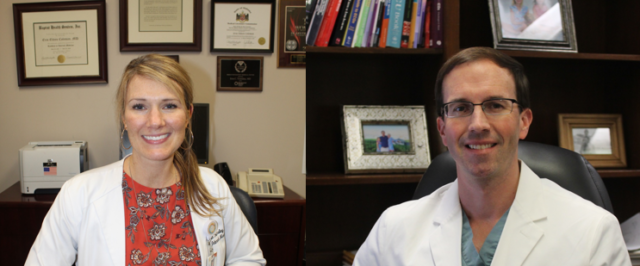By Ameera Steward
For the Birmingham Times
November is Diabetes Awareness Month, a time to raise understanding about diabetes, an illness that affects millions of Americans of all ages.
There are two types of diabetes: Type 1 and Type 2.
Type 1, once known as juvenile diabetes or insulin-dependent diabetes, is a chronic condition in which the pancreas, an organ located in the abdomen that plays an essential role in converting food into fuel for the body, produces little or no insulin, the hormone needed to allow sugar (glucose) to enter the body’s cells to produce energy.
Type 2 diabetes is a chronic condition that affects the way the body metabolizes glucose, an important source of fuel for the body. With Type 2, the body either resists the effects of insulin or doesn’t produce enough of the hormone to maintain normal glucose levels.
The Birmingham Times recently sat down with two physicians from Brookwood Baptist Health—internal medicine physician Erin Townsley, MD, and interventional cardiologist Hutton Brantley, MD—to discuss and get advice about dealing with diabetes.
Family and Food
People with a family history of Type 2 diabetes are at an increased risk for developing the illness, Townsley said.
“If you have a family history of diabetes and then have the environmental or lifestyle factors that also play a role, … that’s going to increase your risks,” she said. “Just because it’s in your genetics and just because you have a family history doesn’t mean you’re going to definitely get it; it just means you’re at increased risk, compared with someone who doesn’t have a family history and lives that same kind of lifestyle.”
Townsley recommends that those who have diabetes avoid foods high in carbohydrates (sugars, starches, and fibers found in fruits, grains, vegetables, and milk products), such as bread and pasta, as well as limit daily intake of foods with added sugars and excess calories—all of which increase the risks of obesity and diabetes. The other thing to watch is being sedentary or not exercising, which also can increase the risks for being obese and having diabetes.
“There is no cure, per se, but I have seen diabetes essentially resolve with dramatic lifestyle changes … [and] weight loss,” Townsley explained. “Now, that risk will always be there for [some] people, so that never goes away. … But if you can change your lifestyle, lose weight, change your eating habits, and increase your physical activity, you can potentially come off diabetes medications … [and] dramatically reduce your risk for developing complications [from the illness].”
And there are several potential complications. According to the American Diabetes Association, diabetes can increase the risk for many serious health problems, including skin disorders and infections; eye and vision problems, such as glaucoma and cataracts; neuropathy, or nerve damage, particularly in the legs and feet; kidney disease and failure, which can result in the need for dialysis; hypertension, or high blood pressure; and stroke and heart disease.
Symptoms to Watch For
Symptoms associated with diabetes might include tiredness and increased hunger. If blood sugar is really high, it can cause a catabolic reaction (a process in which the body breaks down large molecules for energy) and lead to weight loss. Also, high blood sugar is almost like a diuretic (a substance that causes increased urination), so it can have a water-pill effect and make patients urinate frequently.
Townsley wants people to understand how important it is to recognize diabetes and get it treated early.
“If you know you struggle with being overweight or obese and you have a strong family history of type 2 diabetes, even if you feel like you’re young, … you need to see a physician about it and get tested,” she said. “I think that’s the biggest thing—early detection.”
Sometimes patients with Type 2 diabetes don’t necessarily feel bad or realize that they feel bad, Townsley added. Their blood sugar may be elevated, and they may be slowly developing problems from diabetes, but they don’t feel it on a day-to-day basis.
“Some patients have a hard time understanding the importance of treating [diabetes], so [some] … constantly have elevated blood sugar and don’t necessarily have a lot of symptoms, or at least symptoms they recognize. … Diabetes is sort of a slow process, and patients may not really realize that they’re having issues from it,” she said.
“Complications may not happen tomorrow, next month, or even in three to five years, but they eventually will happen, and it can be 20 years from when [someone] is diagnosed. … It’s really sometimes hard for me to get patients to look at the long goal, … so I spend a lot of time educating patients about the importance of [monitoring diabetes]. The bottom line is most people don’t want to take a lot of medicines, … especially when they get to the point of having to inject insulin, [which is] a really big hurdle for patients to get used to. It’s a lifestyle change to have to do that every day.”
Heart Disease
Brantley said diabetes is considered the highest risk factor development of one particular complication: heart disease — “higher than smoking or high blood pressure.”
“Diabetes with elevated blood glucose damages nerves and blood vessels, making people with diabetes vulnerable to the risk factors for cardiovascular disease: smoking, high blood pressure, abnormal cholesterol levels and triglycerides,” he said. “People with Type 1 and Type 2 [diabetes] are both at risk for early-onset heart disease.”
The heart specialist added that maintaining a healthy weight is best for people with diabetes because being overweight tends to increase blood glucose, blood pressure, and blood fat levels.
“Even a modest 10- to 20-pound weight loss can improve your levels,” he said.
Additionally, regular physical activity is not only associated with better blood glucose levels but also can help reduce blood pressure.
“Aim for at least 30 minutes of moderate-intensity aerobic exercise most days of the week and at least two strength-training sessions per week,” he said.
Brantley also emphasized the importance of not smoking.
“If you have diabetes, you’re already at risk for heart and blood vessel problems. Nicotine only exacerbates the problem by damaging and tightening blood vessels, and raising blood pressure and blood glucose,” he said.
“I recommend that patients talk to their health-care provider and discuss specific risk factors for diabetic heart disease to come up with an individualized treatment plan, including further cardiac evaluation.”



